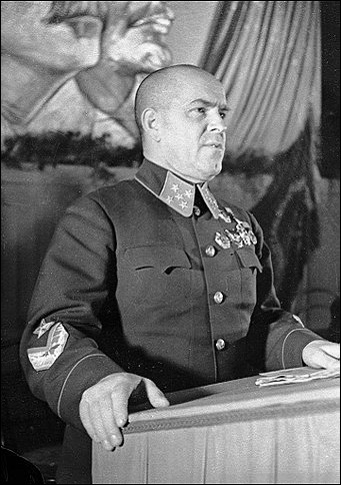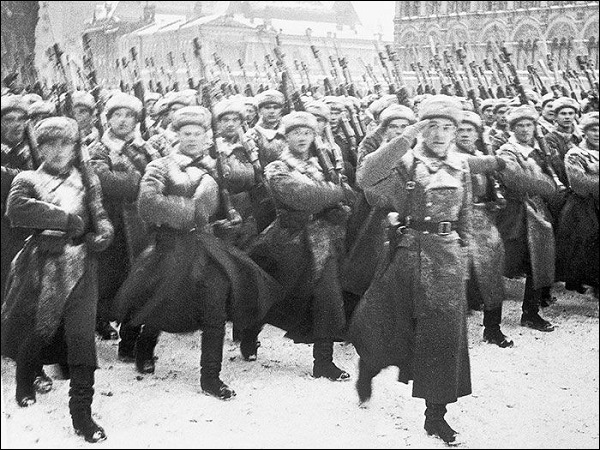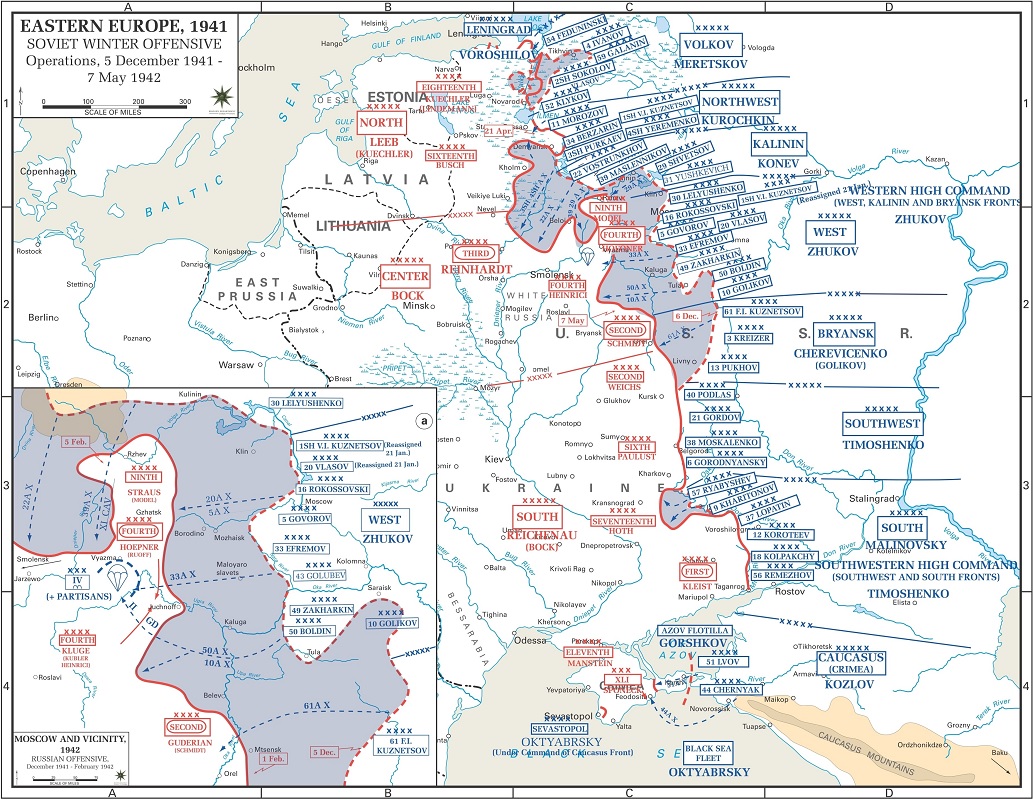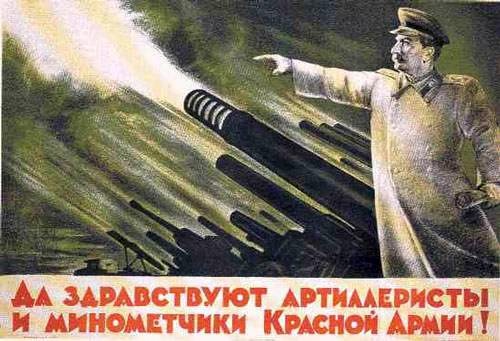● ● ●
The initial phase of the war on the
Eastern Front, from late June to early December 1941, made
it clear to both sides that the issue would not be decided
any time soon. Despite its spectacular run of victories, the
German Army’s advance had stalled at the gates of Leningrad
and Moscow. And despite the astronomical losses it had
sustained, the Red Army still possessed sufficient reserves
of men and material to stay in the fight.
By early December General of Army Georgy
Zhukov, commanding Western
Front, had largely succeeded in bringing the
German Army Group Center to a stop on the approaches
to Moscow. He believed, and persuaded Stalin, that the time
was ripe for a series of counterattacks to drive the enemy
away from the capital and, possibly, to set the stage for a
full counteroffensive. The counterattacks were duly launched
and they soon disclosed that the Germans were not merely
stalled but exhausted. Zhukov therefore decided, with Stalin’s
approval, to go for the big solution: the wholesale
destruction of enemy forces on the central sector of the
front. This Moscow counteroffensive was to evolve into the
Red Army’s first bid for decisive victory, and the first
test of the Red Army's ability to fight the deep battle.

Georgy Konstantinovich Zhukov
on the eve of war in 1941, when serving as Chief of the
General Staff and Deputy Minister of Defense (RIA
Novosti Archive)
The necessary reserves for a
counteroffensive were available: about ninety
rifle divisions, some
coming in from from the Far East and the Caucasus,
some newly raised. To supplement them numerous rifle
brigades, usually with three or four battalions plus a
slender ration of support units, were in process of
formation. Moreover, working with the energy of desperation,
the Red Army had succeeded in reconstituting its armored
forces, albeit on a modest scale. The new basic unit was the
tank brigade,
which was supposed to have 46 light and
medium tanks—though their actual strength was usually lower—plus a small motorized infantry battalion
about 500 men strong. As far as tanks were concerned, these
brigades were less than the size of a full-strength German
panzer battalion, though the addition of an organic infantry
contingent was a sound move. There were also many
independent tank battalions, with 20-25 tanks on average.
It was planned to combine these tank brigades and battalions
into division-sized units called
tank corps, but
nothing much could be done along that line before the Moscow
counteroffensive commenced.
Also introduced into the Red Army’s
order of battle was the
shock army. This major formation, intended to be
particularly strong in artillery and armor, was conceived as
the breakthrough force that would blow a hole in the German
defenses, clearing the way for exploitation by the mobile
forces. When first raised, however, First Shock Army and
Second Shock Army were little more than infantry armies
reinforced with such tank and artillery units as could be
scraped together. In late November, for example, First Shock
Army consisted of one rifle division, nine rifle brigades, a
few tanks battalions, an artillery regiment and a rocket
artillery battalion. Later on, however, the shock armies
became much more formidable.

7 November 1941: Red Army
troops march across Red Square on the anniversary of the
October Revolution (World War II Photos)
Some of these reinforcements had to
be committed to the defense of Moscow but others were used
to form a number of reserve armies. Thus Zhukov judged that he
had sufficient resources for his proposed counteroffensive,
particularly in view of the Germans’ increasingly parlous
situation—the onset of winter having caught them unprepared.
Bitter cold and deep snow immobilized the panzers, making it
next to impossible to conduct a mobile defense. Local Red
Army counterattacks had already compelled the Germans to
carry out successive tactical withdrawals—each of which
involved the abandonment of heavy equipment that could not
be moved along drift-choked roads. Frostbite casualties
multiplied. In the extreme cold even small arms, their
lubricants frozen, ceased to function. Often the only weapon
that could be relied upon to work was the hand grenade.
Zhukov’s plan envisioned two
attacks: one north of Moscow and one south of the capital.
Tactically, the situation was very favorable. The German
divisions, mostly understrength, were thinly spread over
long frontages. Reinforcements and supplies could reach them
only with difficulty via inadequate rail lines and
snow-covered roads. As the Red Army’s preliminary
counterattacks had shown, the enemy was too weak to keep his
front intact, and but marginally capable of conducting a
mobile defense.
The operational objectives of the
counteroffensive were to be the cities behind the German
lines that served as communications hubs and supply centers.
Prominent among them was Vyazma, about a hundred miles
southwest of Moscow. If it could be captured the entire
German Fourth Army would stand in danger of
encirclement and destruction. Thus everything depended on
the speed with which frontal breakthroughs could be made and
exploited.
In the northern sector the Red
Army’s counteroffensive began on the night of 4-5 December;
the attack in the south jumped off a day later. As expected
the German front proved porous. The tactical scheme was for
the Soviet infantry to overrun the German defensive
positions or, if possible, to infiltrate past them, opening
the way for the mobile forces. These were hastily organized
battle groups combining tank, cavalry and motorized
infantry units; their mission was to strike deep into the enemy’s
rear areas. But problems soon accumulated. As a directive
issued by West Front on 9 December complained:
Some of our units are pushing
the enemy back frontally instead of outflanking and
encircling him. Or they stand before the enemy’s
position, complaining about difficulties and heavy
losses. This gives the enemy time to withdraw to a new
line, regroup and organize his defenses afresh.
Thus, though the enemy was driven
back frontally, the decisive operational stroke miscarried.
Despite the gaps in their front the Germans managed to
retain their cohesion, and the hoped-for decisive
breakthrough was not achieved.
Even so the counteroffensive was a
great shock to the Germans. Material losses, particularly of
tanks, artillery and vehicles of all kinds, mounted with
alarming rapidity. Divisions shrank to the size of regiments
or battalions. As the defenders staggered under the Red
Army’s blows, the nightmare vision of Napoleon’s disastrous
retreat from Moscow in 1812 rose before their eyes. On 20
December, Colonel-General Erich Hoepner, commanding
Fourth Panzer Group, notified Army Group Center
headquarters that:
The commanding generals of
XXXXVI and V Corps have reported they cannot hold. Heavy
losses of trucks and weapons in recent days. They had to
be destroyed for lack of fuel. Weapons now 25-30% of
requirements. Only course to give orders to hold to the
last man. The troops will then be finished and there
will be a hole in the line.
Such alarming messages, suggestive
of looming defeat and accompanied by calls for a large-scale
withdrawal to some defensible line farther west, ignited a
command crisis—Hitler’s response to which was the summary
dismissal of numerous senior generals, the
Commander-in-Chief of the Army, Field Marshal Walther von
Brauchitsch, prominent among them. After sacking Brauchitsch
on 19 December, the Führer himself assumed command of the
Army and issued peremptory orders that the troops must stand
and fight. No further voluntary withdrawals would be sanctioned.

The Moscow
Counteroffensive and the General Offensive (Department of
History, USMA West Point)
Hitler’s stand-fast order certainly
stiffened his armies’ resistance and very possibly staved
off a debacle; on the other had it presented the attacker
with numerous opportunities to encircle and destroy
defending German units. But these opportunities the Red Army
proved unable to exploit. The problem was that the new,
hastily organized mobile battle groups lacked the requisite
punch and flexibility. They were too small, their commanders
were inexperienced and their constituent units were unused
to operating as a team. Thus many tactical opportunities
were thrown away and the enemy was given precious time to
regain his balance.
The fighting dragged on into the
new year as Stavka, at Stalin’s instigation, sought to
expand the counteroffensive into a general offensive along
the whole front. He lectured his generals that the Germans
were staggering after the battles west of Moscow; now was
the time to finish them off. Only Zhukov spoke against this,
arguing that the Red Army lacked the necessary means to make
such a gigantic operation possible. He proposed instead to
concentrate all efforts on the Moscow front, against
Army Group Center. As usual, however, Stalin had his
way. The general offensive was ordered. Its objectives were
to break the siege of Leningrad, complete the destruction of
the German forces facing Moscow, recapture the Donets basin
and liberate the Crimea. Reserves were committed on a large
scale and nine of the ten fronts (army groups) facing the
Germans were to be set in motion.

"Long live the gunners of the Red Army!"
Stalin directs his artillery (All World Wars)
But Zhukov’s forecast proved
correct and the general offensive fell far short of Stalin's
expectations. In the Leningrad sector nothing much was
achieved despite heavy fighting and high casualties; in the
south ground was gained but no decisive success was scored.
West of Moscow, the Red Army did come tantalizingly close to
encircling Army Group Center but
once again the Germans managed to stave off disaster—though
if Zhukov had had his way, things might have turned
out differently.
The Russian attacks became more and
more spasmodic as casualties, supply problems and German
resistance mounted. Ultimately, the Red Army proved unable
to bring off the hoped-for decision before the spring
thaw—the rasputitsa or season of mud—called a
temporary halt to all operations. Thus the general offensive
ended on a note of disappointment. To be sure, the Stalin
could claim a victory. The Germans had suffered high
casualties, lost much material and were driven back from the
gates of Moscow. But the enemy, though down, was not out.
Both tactically and operationally,
the Moscow counteroffensive and the subsequent general
offensive showed that the Red Army lacked both the tactical
expertise and the proper organization to fight the deep
battle. But out of the cauldron of the war’s first phase
there began to emerge cadres of commanders at all levels,
experienced and tested in battle. And the emergency
reorganization of the Red Army set in train by Stavka in
response to the initial defeats would put into the hands of
these commanders a military instrument in line with Soviet
capabilities—an instrument whose first test would come in
the 1942 summer campaign, culminating in the Battle of
Stalingrad.
● ● ●